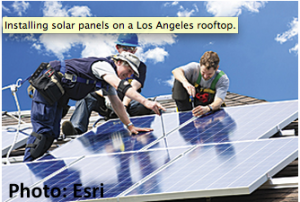According to the research report “Los Angeles Solar: Now and into the Future”, city utilities must overcome implementation challenges in order to continue the growth of solar energy. The report, commissioned by the Los Angeles Business Council Institute, finds that the Los Angeles Department of Water and Power (LADWP) has the opportunity to wean itself from polluting coal-fired power – currently 42 percent of its energy portfolio – and expand the amount of local solar to 1,500 megawatts annually.
Researchers from UCLA’s Luskin Center for Innovation and the USC Program for Environmental and Regional Equity (PERE), found that a program of this scale would also be an economic catalyst, creating thousands of new solar-related jobs and attracting significant long-term investment to Los Angeles. The report cites three strategies in which solar expansion can be achieved: net metering, Feed-in Tariff (FiT) program and the Community Solar Initiative. The FiT can play a lead role, according to the researchers. This program, launched in 2012, enables local commercial property owners to sell solar power generated from rooftops and parking lots back to LADWP at a competitive fixed rate.
 To date, LADWP has authorized 100 MWof power under the FiT program; however, only 6.5 MW are operational, according to the UCLA/USC study. Another 8.2 MW of projects are under contract and awaiting construction, with another 56 MW in the contracting stage. The FiT evaluation concludes that LADWP needs to build its staff resources and continue streamlining the application and installation processes to speed the pace of approving local solar projects if it is to reach a self-imposed deadline to be coal-free by 2025.
To date, LADWP has authorized 100 MWof power under the FiT program; however, only 6.5 MW are operational, according to the UCLA/USC study. Another 8.2 MW of projects are under contract and awaiting construction, with another 56 MW in the contracting stage. The FiT evaluation concludes that LADWP needs to build its staff resources and continue streamlining the application and installation processes to speed the pace of approving local solar projects if it is to reach a self-imposed deadline to be coal-free by 2025.
Spearheaded by the Los Angeles Business Council Institute and the CLEAN LA Solar Coalition, the FiT program provides an opportunity for the LADWP to access the abundant solar energy available on more than 10,000 acres of rooftops in Los Angeles. More than 40 percent of the projects in the FiT’s first three 20 MW tranches are located in “solar equity hotspots” – neighborhoods with abundant rooftops and great need for economic investment and jobs. The hotspot areas exist in the San Fernando Valley, East Los Angeles, and areas west of Downtown, including Hollywood. In many cases, solar training programs that target less advantaged workers, such as participants in Homeboy Industries’ Solar Panel Training and Installation program, are located in or near the hotspot areas.
“Los Angeles has a unique confluence of characteristics providing a firm foundation for a successful solar FiT program: abundant sunshine, a trained workforce and tremendous economic need,” said Dr. Manuel Pastor, Director of the USC Program for Environmental and Regional Equity. “Growing the FiT will bring economic opportunity to some of our city’s most underserved and environmentally-challenged neighborhoods. There’s no question that the FiT can advance solar-related equity goals where they’re needed most.”
In part due to Councilmember Bob Blumenfield’s efforts, FiT applicants can now access lower-cost PACE financing to help make projects financially more viable by removing traditional cost barriers. “As an Assemblymember, I advocated for PACE financing as an innovative vehicle for financing energy and water efficiency upgrades. As a Councilmember, I am working to provide Angelenos with access to PACE financing,” Blumenfield said. “Residential, commercial and industrial buildings are eligible for this innovative, low-cost financing which can be coordinated with LADWP incentives.”
LADWP has already reduced project wait times from an average of 425 days for the initial projects down to an average of 182 days more recently, due in large part to a new online application and permitting system that has helped streamline the process. Also, certain insurance requirements have been removed to reduce barriers for solar developers, and changes to standard contracts create more certainty for applicants and help streamline financing options.
But more needs to be done, according to the UCLA/USC findings. Project wait times can see a sustained decline only with a significant increase in staffing at LADWP to review applications and do the technical work needed to greenlight projects, according to the findings.
“LADWP needs to staff up in order to fulfill the promise of the FiT program and meet the high priority placed on the program by Mayor Garcetti, the City Council and the Board of DWP Commissioners,” said the evaluation’s co-researcher J.R. De Shazo, Director at UCLA’s Luskin Center. “Los Angeles has the right amount of sun, available rooftops, trained workers and financing options. Adequate staffing at LADWP is the missing piece of the puzzle, and it needs to be put in place if Los Angeles is going to go reach its solar potential.”
In preparation for continued growth in solar energy, the Los Angeles Business Council launched a new website to connect solar and community developers with building owners. The site lists 7,000 properties that are ripe for rooftop solar development, and includes building addresses, names of property owners and overall capacity of rooftop solar systems.
“We know how important the list of potential properties was to identifying projects during the launch phase of the FiT,” added LABC President Mary Leslie. “We’ve taken that list to the next level to provide an online marketplace that will facilitate the expansion of the FiT that we know is possible. LABC is confident that the online listing will spur additional solar investment by posting the most opportune sites in the City of Los Angeles.”

